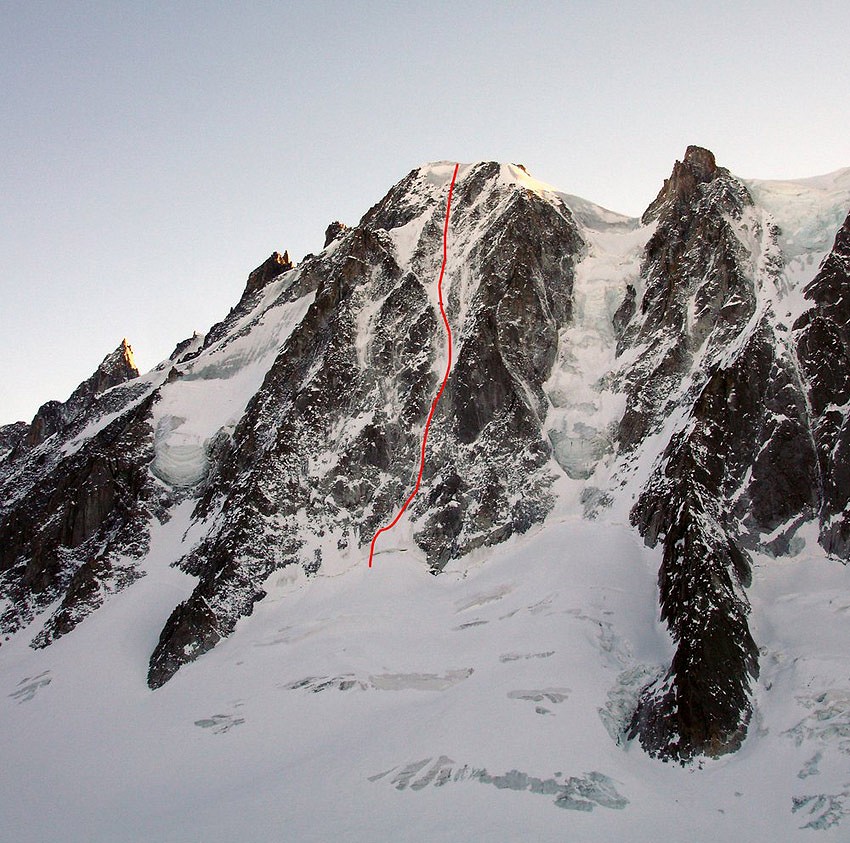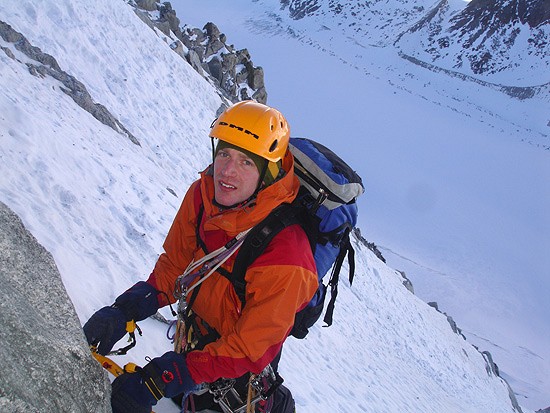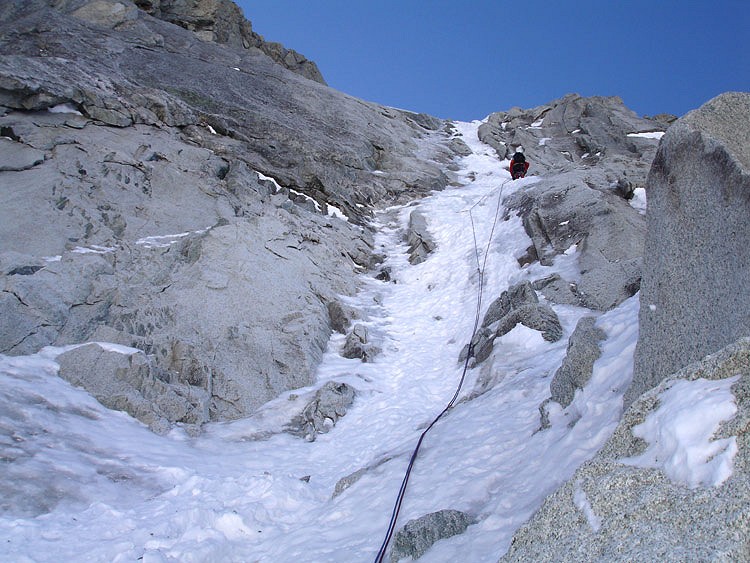
Also Read The North Face Races - Gordon Smith's historical Alpine Article
Also Read Courting the Easy Way - Mike C's historical Alpine Article
Also Read Alpine Introduction by Rich Cross
Swiss Route – North Face of Les Courtes
One of the classic ice climbs of the Alps, tackling the ice-encrusted north face of Les Courtes, the Swiss Route is an ideal introduction to winter north face climbing. Pitch after pitch of steep ice and neve, weave through jagged rock bands; giving exhilaratingly exposed climbing, interspersed with occasional opportunities for protection. At 'only' 800m in length the route is quite comfortably climbed in a day and this, coupled with the relative lack of objective dangers, place it high on many climbers wish lists.
The decade prior to the Second World War heralded countless new routes at a level of difficulty above anything that had come before; the north faces of the Alps were ticked off one by one. The Swiss Route, first climbed in July of 1938 by C Cornaz and R Mathey (the same year that the infamous Eiger north face was conquered and also the superb Walker Spur on the Grande Jorasses) was a major prize plucked in a frantic few years of activity in the Alps. The previous year - '37 had seen the North East Spur on the neighbouring north face of Les Droites climbed for the first time and both this and the Swiss Route have now become classic adventures of the Argentiere basin. The basin itself is extremely picturesque, on one side sit the friendly Aiguille du Chardonnet and Aiguille d'Argentiere, on whose lower slopes balances the ski-lodge-esque Agentiere hut. On the opposite side of the glacier the continuous mass of huge north faces; The Aiguille Verte, Les Droites and Les Courtes, hulk angrily, brooding and blocking the sunlight and every so often shrugging off several tonnes of snow and ice.


We skinned up the Argentiere glacier under a perfect blue sky. I was un-acclimatised and unfit, fresh from the desk and wondering what on earth to do with these ski-things on my feet. I managed to keep up with Adrian, just. We skied to the Argentiere hut, which is on the opposite side of the basin, with a grand view of all the north faces and only twenty minutes or so from the base of Les Courtes.
An Alpine start saw us skinning to the base of the route, the blue lights of our head-torches bobbing like ducks on water as we settled in to the rhythm of skiing. The base of the route was obvious and a boot track led us straight through the small bergshrund and on to an initial snow slope. Whilst making a bee-line for the crux couloir, Adrian accidentally climbed some tricky mixed ground (which turned out to be the hardest climbing on the route) before we got established on the route itself.
The main difficulties were then concentrated in the first few pitches; steep ice dribbled down through chute-like couloirs, giving dreamy climbing reminiscent of Comb Gully on Ben Nevis (around Scottish III/IV). Belays and rock protection were available to rest the mind, but not the calves. The upper neve slopes stretched endlessly above, never desperate, but unrelentingly continuous (55 degrees or Scottish II). The sweep of air beneath our feet seemed to add at least a grade to what would have been, at the lower altitudes of Scotland, very straightforward climbing. We moved together for most of the upper face - stopping to belay not for safety but to rest our legs!
Cresting the summit ridge to be kissed full in the face by the afternoon sun, the hard work was over, but we still had a long way to go before the taste of over priced and under flavoured Chamonix beer hit our frost-cracked lips. The usual winter descent is via the NE Slope; a 50 degree, leg burning snow slope, patched with bullet hard ice, ready to catch out the tired Alpinist and send him on a quick ride to the Argentiere Glacier 1000m below. The slope should be avoided in avalanche conditions, as Joe Simpson found out, but can be down-climbed quickly under reasonable snow conditions by a competent party. The sides of the slope are flanked by rock spurs, offering abseil anchors if needed. We made two abseils at the top of the slope and then down climbed the rest of the way.

The Approach: (to the hut)
From the top of the Grand Montets lift; Follow the metal ladders down on to the Col des Grande Montets. Follow the piste to your left and then drop down rightwards in to the Argentiere basin - following the Glacier des Rognons (sometimes this is ski tracked - various possibilities). Follow the centre of the glacier gently up the valley and then climb the final 100m steeply up to the Argentiere Hut on the left side of the valley (looking up). 1hr 30mins from the Grande Montets lift. Les Courtes is opposite the hut and reached by crossing the glacier by the safest route.
The Route:
An 800m snow and ice climb of extremely high quality. Expect around two or three pitches of Scottish III or IV in the lower third, with adequate ice-screw protection and comfortable belay stances. The upper two-thirds is a continuous neve slope, with occasional ice patches (for screws) and small rock outcrops on either side (rock gear).
Descent via NE Slope:
Traverse the summit ridge of Les Courtes (rocky scrambling) for approximately 200m until above the large snow slope of the NE Slope. The slope is steepest at the top - it is possible to abseil from large blocks. A rock rognon sits in the centre of the slope around 150m below the summit ridge. From this rognon we found it possible to down climb - this is dependant on snow conditions.

Tips for success:
Skiing: A basic ski touring set-up is essential for winter travel in the mountains of the Alps. Modern ski-touring boots are perfectly adequate for climbing even up to the most technical levels. We climbed the Swiss route in touring boots and had comfortable and warm feet for the whole climb.
Acclimatisation: We climbed a shorter route near the Aiguille du Midi, spending a night up at 3000m. This was only just adequate acclimatisation and we both felt the altitude on the route. Two warm up routes would be a better idea for the totally un-acclimatised.
Rack and equipment: Light isn't always right! Temperatures were very low when we climbed the route - we took thick belay jackets and extra mitts and carried a two man bothy shelter. Where we did save weight was with the rack. Protection is sparse; a few screws and a very light rack of nuts sufficed for our ascent.
Guidebook: We used the fantastic 'Snow, Ice and Mixed' guide book by Francios Damilano (Volume 1) ISBN: 2-9521881-2-2.
Read Guy Willet's UKC Ski Touring Article HERE
Read Doug Evan's UKC Ski Mountaineering Article HERE
Read Jon Griffith's Black Diamond Ski Review HERE
Read Jack Geldard's Mammut Belay Jacket Review HERE
Watch a video of an ascent of the Swiss Route on TVMountain.com
Thanks to Adrian Jebb for supplying the photographs to illustrate this article.








Comments